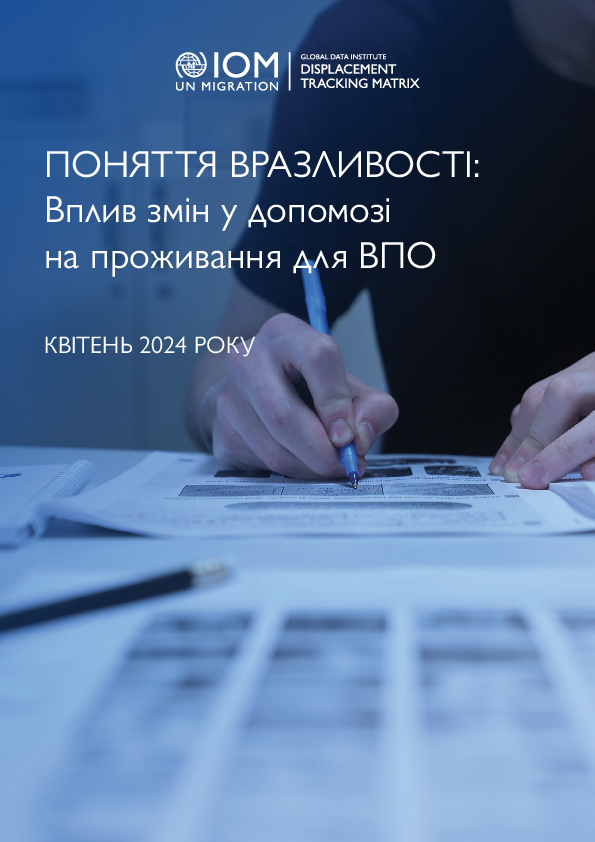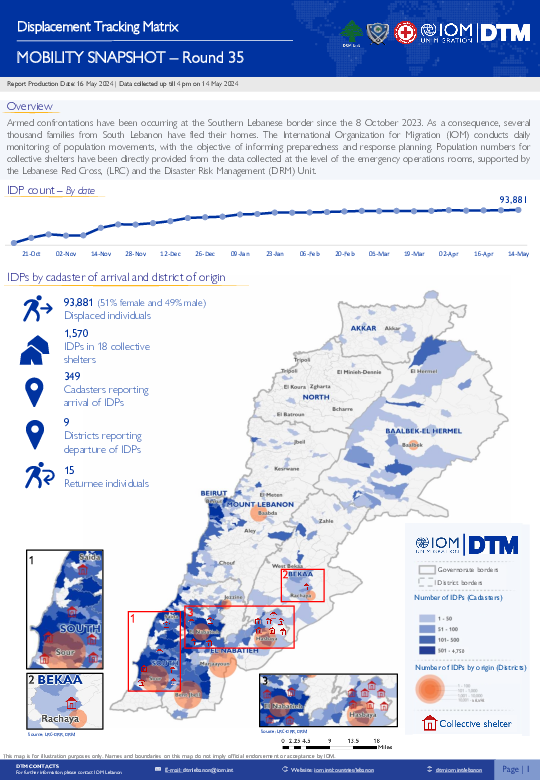-
Countries
-
Data and Analysis
-
Special Focus
-
Crisis Responses

Contact
DTM Ukraine, dtmukraine@iom.int
Language
English
Location
Ukraine
Snapshot Date
Mar 01 2024
Activity
- Other
Зміни до критеріїв отримання допомоги, які набули чинності в березні 2024 року, обмежили доступ до допомоги на проживання ВПО на основі певного набору профілів соціально-економічної вразливості. Запровадження додаткових критеріїв має на меті забезпечити, щоб соціальна допомога в Україні була здатна підтримати найбільш вразливі верстви населення, як серед переміщених осіб, так і серед населення в цілому. Однак це збільшує ризик виключення деяких вразливих осіб, які можуть втратити доступ до допомоги на проживання ВПО за новими критеріями. Таке скорочення щомісячного доходу домогосподарств може вплинути на здатність вразливих домогосподарств задовольняти свої базові потреби та відновлювати своє життя.
Мета цього тематичного нарису — надати огляд оціночної частки та кількості ВПО, які все ще можуть мати право на отримання грошової допомоги ВПО за новими критеріями. Використовуючи наявні вторинні дані, цей тематичний нарис має на меті надати орієнтовний огляд частки та кількості ВПО, які більше не матимуть права на отримання допомоги, незважаючи на те, що вони є вразливими до скорочення доходів домогосподарств, яке може вплинути на їхню здатність задовольняти базові потреби. Цей документ має на меті інформувати та підтримувати адвокаційну діяльність і розробку програм гуманітарних партнерів на додаток до нової схеми виплати грошової допомоги ВПО.
Примітка: Ця записка була переглянута 26 квітня 2024 року, щоб відобразити останні зміни до Постанови 332, які набули чинності 22 березня. Очікуваний вплив тепер відображає найновіші критерії для отримання права на отримання грошової допомоги на проживання для ВПО

Contact
iompanama@iom.int
Language
Spanish
Location
Panama
Period Covered
Aug 01 2023
Feb 29 2024
Activity
- Survey
a región de América Central y México se ha caracterizado por ser uno de los corredores migratorios más importantes del mundo. A lo interno se pueden identificar varios flujos migratorios. Por ejemplo, el tránsito de personas migrantes altamente vulnerables provenientes de Centro y Sur América, el Caribe, Asia y África con rumbo hacia el norte del continente. Así como la migración circular por movilidad laboral, entre fronteras de dos o más países.
Este último tipo de migración puede entenderse como un patrón de movilidad humana internacional continuo, a largo plazo y fluido, entre países que crecientemente son reconocidos como parte de un mismo espacio económico.
Este tipo de movilidad existe en la frontera entre Panamá y Costa Rica desde hace décadas, la población indígena Ngäbe - Buglé se moviliza desde sus tierras actuales a las zonas altas de la provincia de Chiriquí y la Zona Sur de Costa Rica para trabajar principalmente como recolectores en el cultivo de café durante las zafras o períodos de alta cosecha.
Cada año, desde julio hasta por seis meses se inicia la movilización de personas migrantes para trabajar en la cosecha de café. En promedio, el Servicio Nacional de Migración (SNM) de Panamá, emite nueve mil salvoconductos a población indígena Ngäbe - Buglé al año, para su cruce fronterizo y trabajo en Costa Rica. Estos documentos de viaje forman parte de la colaboración interinstitucional del SNM y el Ministerio de Trabajo y Desarrollo Laboral de Panamá, gobiernos locales, y contrapartes costarricenses que coordinan la migración laboral regular de trabajadores y trabajadoras Ngäbe - Buglé, para la provisión de servicios y protecciones en sus lugares de empleo temporal.

Contact
iomnigeriadtm@iom.int
Language
English
Location
Nigeria
Period Covered
May 06 2024
May 12 2024
Activity
- Other
On 7 May 2024, armed bandits attacked Sakajiki community in Kaura Namoda LGA, Zamfara State. The incident led to three fatalities and four injuries, affecting 219 homes and 1,097 individuals. Among the affected were 614 children, 259 women, and 224 men. The displaced population moved to neighboring communities within Kaura Namoda LGA, including Arewa, Shiyar Nafiu, and Sabon gari. The attack resulted in the destruction or severe damage of 40 shelters and the loss of many possessions of households.
Of all the needs identified, food and non-food items (NFIs) were the most prevalent. Other needs included security, shelter, and health services.
Following these events, DTM (Displacement Tracking Matrix) field staff conducted rapid assessments to inform the humanitarian community and Government/partners, and to enable a targeted response.
Nigeria’s north-central and north-west zones are afflicted with a multi-dimensional crisis. Long-standing tensions between ethnic and religious groups often result in attacks and banditry or hirabah. These attacks involve kidnapping and grand larceny along the major highways by criminal groups. During the past years, the crisis has intensified and has resulted in widespread displacements across the north-central and north-western regions.

Contact
DTM South Sudan, SouthSudanDTM@iom.int
Language
English
Location
South Sudan
Period Covered
Apr 01 2024
Apr 30 2024
Activity
- Registration
- Biometric Registration
Between 1 and 30 April 2024, IOM’s Displacement Tracking Matrix (DTM) interviewed 1,106 households representing 7,810 household members to assess the beneficiary satisfaction among service-receiving IDPs during distributions in Bentiu IDP Camp.
Contact
dtmlebanon@iom.int
Location
Lebanon
Activity
- Mobility Tracking
- Baseline Assessment
Period Covered
Oct 10 2023 -Mar 14 2024
Since October 8 there has been an increase in cross-border incidents between Israel and Lebanon, resulting in the displacement of people both within the South and elsewhere within the country. Since October 10, the Displacement Tracking Matrix (DTM) has been conducting the daily monitoring of population movements. The objective of the exercise is to inform preparedness and response planning.
Population Groups
IDPs
Survey Methodology
Unit of Analysis Or Observation
Admin Area 2
Admin Area 3
Household
Individual
Type of Survey or Assessment
Key Informant
Keywords
Geographical Scope Full Coverage
Administrative boundaries with available data
The current dataset covers the following administrative boundaries
May 16 2024
Print
Contact
DTM Ethiopia, DTMEthiopia@iom.int
Location
Ethiopia
Activity
- Mobility Tracking
- Village Assessment
Period Covered
Nov 23 2023 -Dec 31 2023
Between November and December 2023, IOM’s DTM deployed Site Assessment (SA) Round 35 and Village Assessment Survey (VAS) Round 18.
According to data collected through the Site Assessment round 35 November and December 2023, an estimated 3,194,413 IDPs (635,724 IDP households) were internally displaced across 2,662 assessed, accessible sites in Ethiopia. Conflict is the primary cause of displacement and displaced almost 2.2 million IDPs (68.7%), followed by drought which displaced an estimated 536,343 IDPs (16.8%). Somali region hosts the highest number of IDPs primarily displaced by drought nationwide (an estimated 391,573 individuals or 73% of the national drought caseload), while Tigray region hosts the highest number of IDPs primarily displaced by conflict nationwide (an estimated 831,002 individuals or 37.9% of the national conflict caseload).
Population Groups
Residents
Returnee (Previously Internally Displaced)
Survey Methodology
Unit of Analysis Or Observation
Admin Area 2
Admin Area 3
Admin Area 4
Community
Site or Location
Type of Survey or Assessment
Key Informant
Keywords
Geographical Scope
Administrative boundaries with available data
The current dataset covers the following administrative boundaries
Contact
DTM Ethiopia, DTMEthiopia@iom.int
Location
Ethiopia
Activity
- Mobility Tracking
- Site Assessment
Period Covered
Nov 23 2023 -Dec 31 2023
Between 23 November and 31 December 2023, IOM’s DTM deployed Site Assessment (SA) Round 35 and Village Assessment Survey (VAS) Round 18. SA is conducted in locations hosting a reported 20 or more IDP households, and the VAS is conducted in locations hosting a reported 20 or more returning IDP households that returned after 1 January 2022. It is to be noted that South Ethiopia region was not included due to operational constraints. Furthermore, the dataset for Amhara region is available separately, as a multisectoral location assessment was carried out within the region.
Population Groups
IDPs
Survey Methodology
Unit of Analysis Or Observation
Admin Area 2
Admin Area 3
Admin Area 4
Site
Type of Survey or Assessment
Key Informant
Keywords
Geographical Scope Partial Coverage
Administrative boundaries with available data
The current dataset covers the following administrative boundaries

Contact
DTM Ethiopia, DTMEthiopia@iom.int
Language
English
Location
Ethiopia
Period Covered
Nov 23 2023
Dec 31 2023
Activity
- Mobility Tracking
- Site Assessment
- Village Assessment
Between November and December 2023, IOM’s DTM deployed Site Assessment (SA) Round 35 and Village Assessment Survey (VAS) Round 18.
According to data collected through the Site Assessment round 35 November and December 2023, an estimated 3,194,413 IDPs (635,724 IDP households) were internally displaced across 2,662 assessed, accessible sites in Ethiopia. Conflict is the primary cause of displacement and displaced almost 2.2 million IDPs (68.7%), followed by drought which displaced an estimated 536,343 IDPs (16.8%). Somali region hosts the highest number of IDPs primarily displaced by drought nationwide (an estimated 391,573 individuals or 73% of the national drought caseload), while Tigray region hosts the highest number of IDPs primarily displaced by conflict nationwide (an estimated 831,002 individuals or 37.9% of the national conflict caseload).
According to the data collected through the Village Assessment Survey round 18 between November and December 2023, there were an estimated 2,548,685 returning IDPs (586,187 returning IDP households) across 2,580 assessed, accessible villages in Ethiopia. The highest returning IDP caseloads nationwide were in the regions of Tigray (967,257 returning IDPs, 38%), Amhara (an estimated 951,931 returning IDPs, 37.3%) and Afar (an estimated 222,179 returning IDPs, 8.7%).
It is to be noted that South Ethiopia region is not included due to operational constraints. Furthermore, the dataset for Amhara region is available separately, as a multisectoral location assessment was carried out within the region.

Contact
dtmlebanon@iom.int
Language
English
Location
Lebanon
Period Covered
Oct 10 2023
May 14 2024
Activity
- Mobility Tracking
- Baseline Assessment
Since October 8 there has been an increase in cross-border incidents between Israel and Lebanon, resulting in the displacement of people both within the South and elsewhere within the country. Since October 10, the Displacement Tracking Matrix (DTM) has been conducting the daily monitoring of population movements. The objective of the exercise is to inform preparedness and response planning.